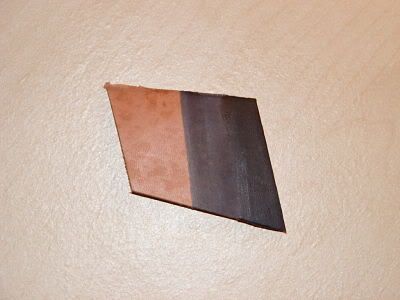I Thought I'd make my 2000th post worthwhile..........
There has been some discussion regarding colouring leather using vinagaroon in the past so here is how I make and use it.
MAKING VINEGAROON
‘Ingredients’ – Steel wool & Distilled Vinegar
This batch was made using an old brillo pad which was washed till no soap remained then left to rust in a jar.

To speed the rusting along I rinse the wool with a little water then pour out the excess to keep it damp for a few days.

Fill up your jar with the wool in it with distilled vinegar (this is Tesco value brand!)

And give it a good shake – it will look like brown muddy sludge – NOTE – ensure you loosen off the lid aftwards! (it will produce gas and build up pressure while ‘brewing’ and it can explode if you leave the lid firmly on.

After a few days it will look like this – you can see the bubbles still being produced!

Lock the lid back on and give it another good shake before loosening off and leaving for another couple of days – repeat this for about a week till the wool is dissolved away.
It will probably still be cloudy sludge looking so I filter through a piece of kitchen paper to take out the big bits

Once filtered it should look a little like weak back tea – ENSURE you label it well!

You can use it straight away but I have found it better to leave it a couple of days to ‘mature’ – it kinda clears and looks more like a liquid rather than a solution if that makes sense.
USING VINEGAROON
It’s simple - really simple! Either dip your veg tanned leather into the solution or daub / brush it on. It starts to darken almost immediately. You may have to do 2 or 3 applications to get the colour you want although it does darken and look better once it is oiled or waxed (I use mink oil)
To neutralize the acid I soak a couple of times in a strong bicarbonate of soda solution then finally rinse in clean water.
Here is a before shot of my demo piece of leather beside a white sheet of paper

A link to a(poor and out of focus) video of the process to show the speed of the change
http://www.youtube.com/watch?v=EkOLb5QOf5U
And finally a pic of the result (before neutralizing and oiling!)

Please note this is not a dye - it changes the structure of the leather itself so it will not wear off - however I find it gives a more even effect and is very quick and cheap!
FINALLY..... ONE I MADE EARLIER!
A sheath I made to show the effect on an actual piece

There has been some discussion regarding colouring leather using vinagaroon in the past so here is how I make and use it.
MAKING VINEGAROON
‘Ingredients’ – Steel wool & Distilled Vinegar
This batch was made using an old brillo pad which was washed till no soap remained then left to rust in a jar.

To speed the rusting along I rinse the wool with a little water then pour out the excess to keep it damp for a few days.

Fill up your jar with the wool in it with distilled vinegar (this is Tesco value brand!)

And give it a good shake – it will look like brown muddy sludge – NOTE – ensure you loosen off the lid aftwards! (it will produce gas and build up pressure while ‘brewing’ and it can explode if you leave the lid firmly on.

After a few days it will look like this – you can see the bubbles still being produced!

Lock the lid back on and give it another good shake before loosening off and leaving for another couple of days – repeat this for about a week till the wool is dissolved away.
It will probably still be cloudy sludge looking so I filter through a piece of kitchen paper to take out the big bits

Once filtered it should look a little like weak back tea – ENSURE you label it well!

You can use it straight away but I have found it better to leave it a couple of days to ‘mature’ – it kinda clears and looks more like a liquid rather than a solution if that makes sense.
USING VINEGAROON
It’s simple - really simple! Either dip your veg tanned leather into the solution or daub / brush it on. It starts to darken almost immediately. You may have to do 2 or 3 applications to get the colour you want although it does darken and look better once it is oiled or waxed (I use mink oil)
To neutralize the acid I soak a couple of times in a strong bicarbonate of soda solution then finally rinse in clean water.
Here is a before shot of my demo piece of leather beside a white sheet of paper

A link to a(poor and out of focus) video of the process to show the speed of the change
http://www.youtube.com/watch?v=EkOLb5QOf5U
And finally a pic of the result (before neutralizing and oiling!)

Please note this is not a dye - it changes the structure of the leather itself so it will not wear off - however I find it gives a more even effect and is very quick and cheap!
FINALLY..... ONE I MADE EARLIER!
A sheath I made to show the effect on an actual piece


 and a really excellent demo
and a really excellent demo 
